Shiji Song
Emulating Human-like Adaptive Vision for Efficient and Flexible Machine Visual Perception
Sep 18, 2025Abstract:Human vision is highly adaptive, efficiently sampling intricate environments by sequentially fixating on task-relevant regions. In contrast, prevailing machine vision models passively process entire scenes at once, resulting in excessive resource demands scaling with spatial-temporal input resolution and model size, yielding critical limitations impeding both future advancements and real-world application. Here we introduce AdaptiveNN, a general framework aiming to drive a paradigm shift from 'passive' to 'active, adaptive' vision models. AdaptiveNN formulates visual perception as a coarse-to-fine sequential decision-making process, progressively identifying and attending to regions pertinent to the task, incrementally combining information across fixations, and actively concluding observation when sufficient. We establish a theory integrating representation learning with self-rewarding reinforcement learning, enabling end-to-end training of the non-differentiable AdaptiveNN without additional supervision on fixation locations. We assess AdaptiveNN on 17 benchmarks spanning 9 tasks, including large-scale visual recognition, fine-grained discrimination, visual search, processing images from real driving and medical scenarios, language-driven embodied AI, and side-by-side comparisons with humans. AdaptiveNN achieves up to 28x inference cost reduction without sacrificing accuracy, flexibly adapts to varying task demands and resource budgets without retraining, and provides enhanced interpretability via its fixation patterns, demonstrating a promising avenue toward efficient, flexible, and interpretable computer vision. Furthermore, AdaptiveNN exhibits closely human-like perceptual behaviors in many cases, revealing its potential as a valuable tool for investigating visual cognition. Code is available at https://github.com/LeapLabTHU/AdaptiveNN.
Does Reinforcement Learning Really Incentivize Reasoning Capacity in LLMs Beyond the Base Model?
Apr 18, 2025Abstract:Reinforcement Learning with Verifiable Rewards (RLVR) has recently demonstrated notable success in enhancing the reasoning capabilities of LLMs, particularly in mathematics and programming tasks. It is widely believed that RLVR enables LLMs to continuously self-improve, thus acquiring novel reasoning abilities that exceed corresponding base models' capacity. In this study, however, we critically re-examines this assumption by measuring the pass@\textit{k} metric with large values of \textit{k} to explore the reasoning capability boundary of the models across a wide range of model families and benchmarks. Surprisingly, the RL does \emph{not}, in fact, elicit fundamentally new reasoning patterns. While RL-trained models outperform their base models at smaller values of $k$ (\eg, $k$=1), base models can achieve a comparable or even higher pass@$k$ score compared to their RL counterparts at large $k$ values. The reasoning paths generated by RL-trained models are already included in the base models' sampling distribution, suggesting that most reasoning abilities manifested in RL-trained models are already obtained by base models. Further analysis shows that RL training boosts the performance by biasing the model's output distribution toward paths that are more likely to yield rewards, therefore sampling correct responses more efficiently. But this also results in a narrower reasoning capability boundary compared to base models. Similar results are observed in visual reasoning tasks trained with RLVR. Moreover, we find that distillation can genuinely introduce new knowledge into the model, different from RLVR. These findings underscore a critical limitation of RLVR in advancing LLM reasoning abilities which requires us to fundamentally rethink the impact of RL training in reasoning LLMs and the need of a better paradigm. Project Page: https://limit-of-RLVR.github.io
CheXWorld: Exploring Image World Modeling for Radiograph Representation Learning
Apr 18, 2025Abstract:Humans can develop internal world models that encode common sense knowledge, telling them how the world works and predicting the consequences of their actions. This concept has emerged as a promising direction for establishing general-purpose machine-learning models in recent preliminary works, e.g., for visual representation learning. In this paper, we present CheXWorld, the first effort towards a self-supervised world model for radiographic images. Specifically, our work develops a unified framework that simultaneously models three aspects of medical knowledge essential for qualified radiologists, including 1) local anatomical structures describing the fine-grained characteristics of local tissues (e.g., architectures, shapes, and textures); 2) global anatomical layouts describing the global organization of the human body (e.g., layouts of organs and skeletons); and 3) domain variations that encourage CheXWorld to model the transitions across different appearance domains of radiographs (e.g., varying clarity, contrast, and exposure caused by collecting radiographs from different hospitals, devices, or patients). Empirically, we design tailored qualitative and quantitative analyses, revealing that CheXWorld successfully captures these three dimensions of medical knowledge. Furthermore, transfer learning experiments across eight medical image classification and segmentation benchmarks showcase that CheXWorld significantly outperforms existing SSL methods and large-scale medical foundation models. Code & pre-trained models are available at https://github.com/LeapLabTHU/CheXWorld.
EchoWorld: Learning Motion-Aware World Models for Echocardiography Probe Guidance
Apr 17, 2025Abstract:Echocardiography is crucial for cardiovascular disease detection but relies heavily on experienced sonographers. Echocardiography probe guidance systems, which provide real-time movement instructions for acquiring standard plane images, offer a promising solution for AI-assisted or fully autonomous scanning. However, developing effective machine learning models for this task remains challenging, as they must grasp heart anatomy and the intricate interplay between probe motion and visual signals. To address this, we present EchoWorld, a motion-aware world modeling framework for probe guidance that encodes anatomical knowledge and motion-induced visual dynamics, while effectively leveraging past visual-motion sequences to enhance guidance precision. EchoWorld employs a pre-training strategy inspired by world modeling principles, where the model predicts masked anatomical regions and simulates the visual outcomes of probe adjustments. Built upon this pre-trained model, we introduce a motion-aware attention mechanism in the fine-tuning stage that effectively integrates historical visual-motion data, enabling precise and adaptive probe guidance. Trained on more than one million ultrasound images from over 200 routine scans, EchoWorld effectively captures key echocardiographic knowledge, as validated by qualitative analysis. Moreover, our method significantly reduces guidance errors compared to existing visual backbones and guidance frameworks, excelling in both single-frame and sequential evaluation protocols. Code is available at https://github.com/LeapLabTHU/EchoWorld.
Uni-AdaFocus: Spatial-temporal Dynamic Computation for Video Recognition
Dec 15, 2024Abstract:This paper presents a comprehensive exploration of the phenomenon of data redundancy in video understanding, with the aim to improve computational efficiency. Our investigation commences with an examination of spatial redundancy, which refers to the observation that the most informative region in each video frame usually corresponds to a small image patch, whose shape, size and location shift smoothly across frames. Motivated by this phenomenon, we formulate the patch localization problem as a dynamic decision task, and introduce a spatially adaptive video recognition approach, termed AdaFocus. In specific, a lightweight encoder is first employed to quickly process the full video sequence, whose features are then utilized by a policy network to identify the most task-relevant regions. Subsequently, the selected patches are inferred by a high-capacity deep network for the final prediction. The full model can be trained in end-to-end conveniently. Furthermore, AdaFocus can be extended by further considering temporal and sample-wise redundancies, i.e., allocating the majority of computation to the most task-relevant frames, and minimizing the computation spent on relatively "easier" videos. Our resulting approach, Uni-AdaFocus, establishes a comprehensive framework that seamlessly integrates spatial, temporal, and sample-wise dynamic computation, while it preserves the merits of AdaFocus in terms of efficient end-to-end training and hardware friendliness. In addition, Uni-AdaFocus is general and flexible as it is compatible with off-the-shelf efficient backbones (e.g., TSM and X3D), which can be readily deployed as our feature extractor, yielding a significantly improved computational efficiency. Empirically, extensive experiments based on seven benchmark datasets and three application scenarios substantiate that Uni-AdaFocus is considerably more efficient than the competitive baselines.
Bridging the Divide: Reconsidering Softmax and Linear Attention
Dec 09, 2024



Abstract:Widely adopted in modern Vision Transformer designs, Softmax attention can effectively capture long-range visual information; however, it incurs excessive computational cost when dealing with high-resolution inputs. In contrast, linear attention naturally enjoys linear complexity and has great potential to scale up to higher-resolution images. Nonetheless, the unsatisfactory performance of linear attention greatly limits its practical application in various scenarios. In this paper, we take a step forward to close the gap between the linear and Softmax attention with novel theoretical analyses, which demystify the core factors behind the performance deviations. Specifically, we present two key perspectives to understand and alleviate the limitations of linear attention: the injective property and the local modeling ability. Firstly, we prove that linear attention is not injective, which is prone to assign identical attention weights to different query vectors, thus adding to severe semantic confusion since different queries correspond to the same outputs. Secondly, we confirm that effective local modeling is essential for the success of Softmax attention, in which linear attention falls short. The aforementioned two fundamental differences significantly contribute to the disparities between these two attention paradigms, which is demonstrated by our substantial empirical validation in the paper. In addition, more experiment results indicate that linear attention, as long as endowed with these two properties, can outperform Softmax attention across various tasks while maintaining lower computation complexity. Code is available at https://github.com/LeapLabTHU/InLine.
A Unified Interaction Control Framework for Safe Robotic Ultrasound Scanning with Human-Intention-Aware Compliance
Nov 29, 2024



Abstract:The ultrasound scanning robot operates in environments where frequent human-robot interactions occur. Most existing control methods for ultrasound scanning address only one specific interaction situation or implement hard switches between controllers for different situations, which compromises both safety and efficiency. In this paper, we propose a unified interaction control framework for ultrasound scanning robots capable of handling all common interactions, distinguishing both human-intended and unintended types, and adapting with appropriate compliance. Specifically, the robot suspends or modulates its ongoing main task if the interaction is intended, e.g., when the doctor grasps the robot to lead the end effector actively. Furthermore, it can identify unintended interactions and avoid potential collision in the null space beforehand. Even if that collision has happened, it can become compliant with the collision in the null space and try to reduce its impact on the main task (where the scan is ongoing) kinematically and dynamically. The multiple situations are integrated into a unified controller with a smooth transition to deal with the interactions by exhibiting human-intention-aware compliance. Experimental results validate the framework's ability to cope with all common interactions including intended intervention and unintended collision in a collaborative carotid artery ultrasound scanning task.
Advancing Generalization in PINNs through Latent-Space Representations
Nov 28, 2024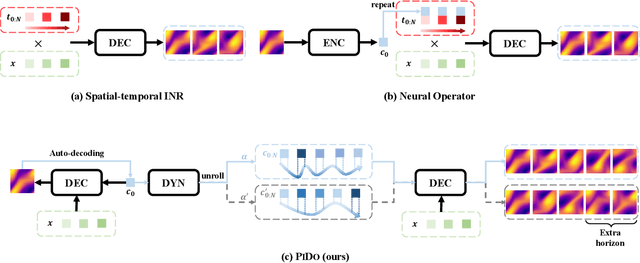
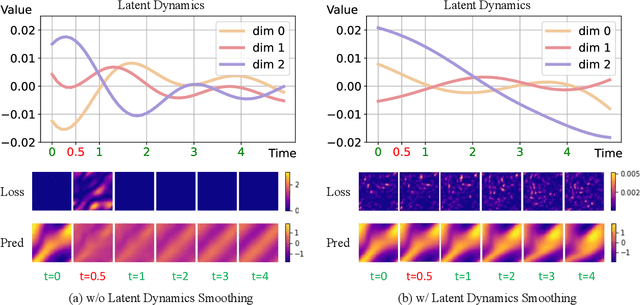

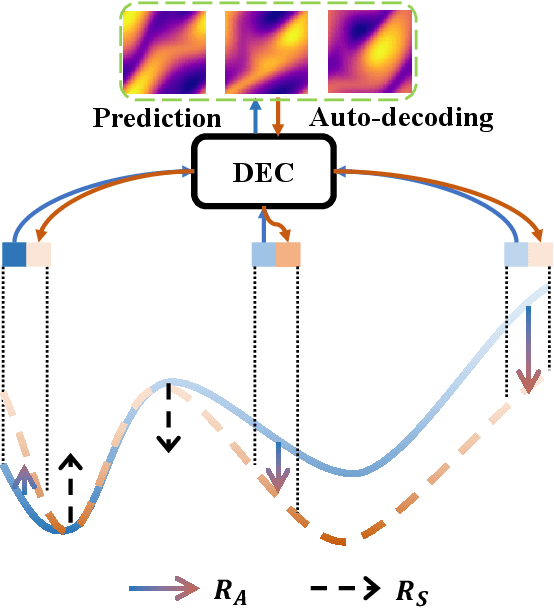
Abstract:Physics-informed neural networks (PINNs) have made significant strides in modeling dynamical systems governed by partial differential equations (PDEs). However, their generalization capabilities across varying scenarios remain limited. To overcome this limitation, we propose PIDO, a novel physics-informed neural PDE solver designed to generalize effectively across diverse PDE configurations, including varying initial conditions, PDE coefficients, and training time horizons. PIDO exploits the shared underlying structure of dynamical systems with different properties by projecting PDE solutions into a latent space using auto-decoding. It then learns the dynamics of these latent representations, conditioned on the PDE coefficients. Despite its promise, integrating latent dynamics models within a physics-informed framework poses challenges due to the optimization difficulties associated with physics-informed losses. To address these challenges, we introduce a novel approach that diagnoses and mitigates these issues within the latent space. This strategy employs straightforward yet effective regularization techniques, enhancing both the temporal extrapolation performance and the training stability of PIDO. We validate PIDO on a range of benchmarks, including 1D combined equations and 2D Navier-Stokes equations. Additionally, we demonstrate the transferability of its learned representations to downstream applications such as long-term integration and inverse problems.
DeeR-VLA: Dynamic Inference of Multimodal Large Language Models for Efficient Robot Execution
Nov 04, 2024



Abstract:MLLMs have demonstrated remarkable comprehension and reasoning capabilities with complex language and visual data. These advances have spurred the vision of establishing a generalist robotic MLLM proficient in understanding complex human instructions and accomplishing various embodied tasks. However, developing MLLMs for real-world robots is challenging due to the typically limited computation and memory capacities available on robotic platforms. In contrast, the inference of MLLMs involves storing billions of parameters and performing tremendous computation, imposing significant hardware demands. In our paper, we propose a Dynamic Early-Exit Framework for Robotic Vision-Language-Action Model (DeeR-VLA, or simply DeeR) that automatically adjusts the size of the activated MLLM based on each situation at hand. The approach leverages a multi-exit architecture in MLLMs, which allows the model to terminate processing once a proper size of the model has been activated for a specific situation, thus avoiding further redundant computation. Additionally, we develop novel algorithms that establish early-termination criteria for DeeR, conditioned on predefined demands such as average computational cost (i.e., power consumption), as well as peak computational consumption (i.e., latency) and GPU memory usage. These enhancements ensure that DeeR operates efficiently under varying resource constraints while maintaining competitive performance. On the CALVIN robot manipulation benchmark, DeeR demonstrates significant reductions in computational costs of LLM by 5.2-6.5x and GPU memory of LLM by 2-6x without compromising performance. Code and checkpoints are available at https://github.com/yueyang130/DeeR-VLA.
OStr-DARTS: Differentiable Neural Architecture Search based on Operation Strength
Sep 22, 2024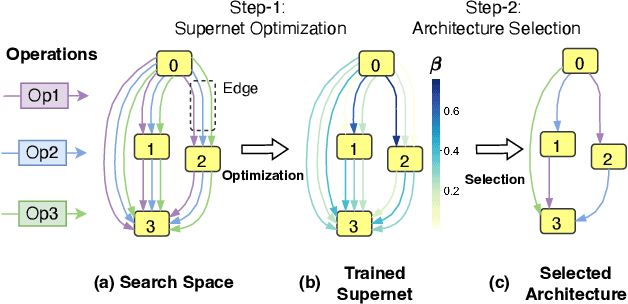
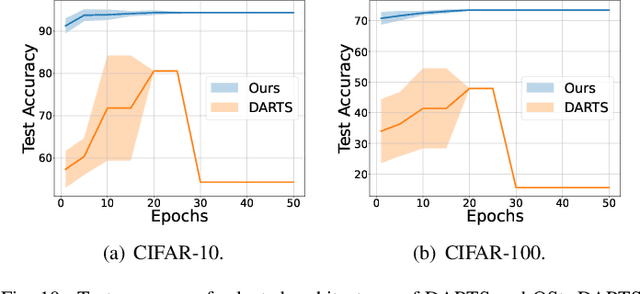
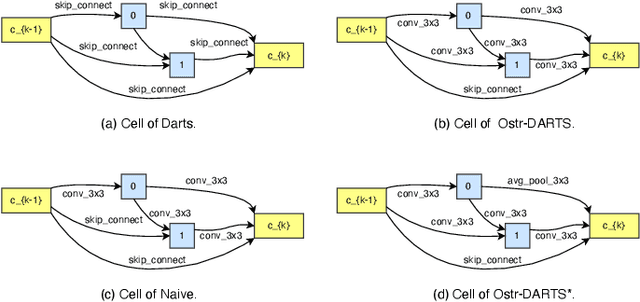
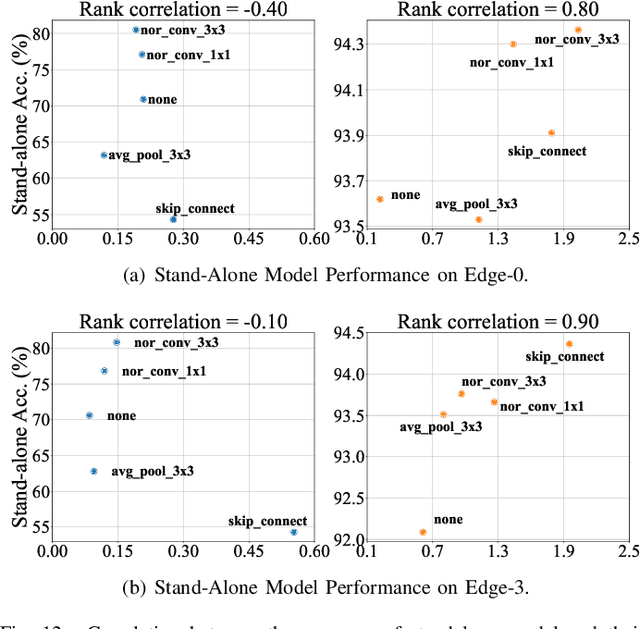
Abstract:Differentiable architecture search (DARTS) has emerged as a promising technique for effective neural architecture search, and it mainly contains two steps to find the high-performance architecture: First, the DARTS supernet that consists of mixed operations will be optimized via gradient descent. Second, the final architecture will be built by the selected operations that contribute the most to the supernet. Although DARTS improves the efficiency of NAS, it suffers from the well-known degeneration issue which can lead to deteriorating architectures. Existing works mainly attribute the degeneration issue to the failure of its supernet optimization, while little attention has been paid to the selection method. In this paper, we cease to apply the widely-used magnitude-based selection method and propose a novel criterion based on operation strength that estimates the importance of an operation by its effect on the final loss. We show that the degeneration issue can be effectively addressed by using the proposed criterion without any modification of supernet optimization, indicating that the magnitude-based selection method can be a critical reason for the instability of DARTS. The experiments on NAS-Bench-201 and DARTS search spaces show the effectiveness of our method.
 Add to Chrome
Add to Chrome Add to Firefox
Add to Firefox Add to Edge
Add to Edge